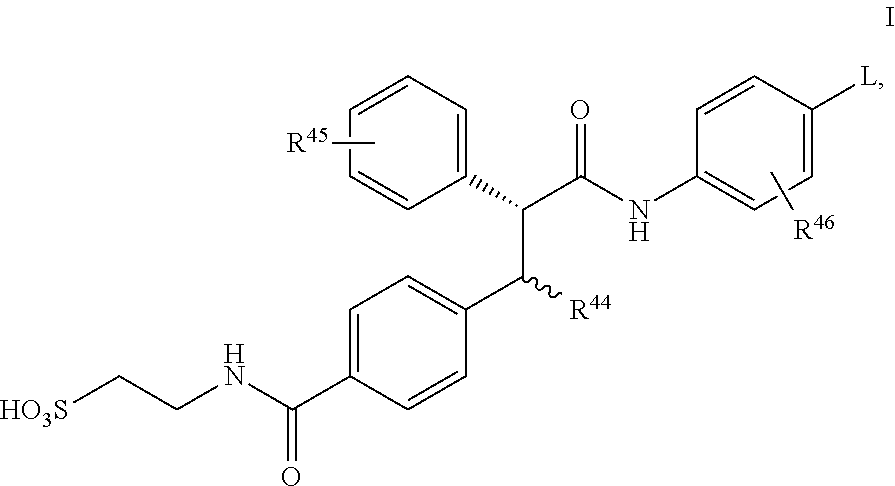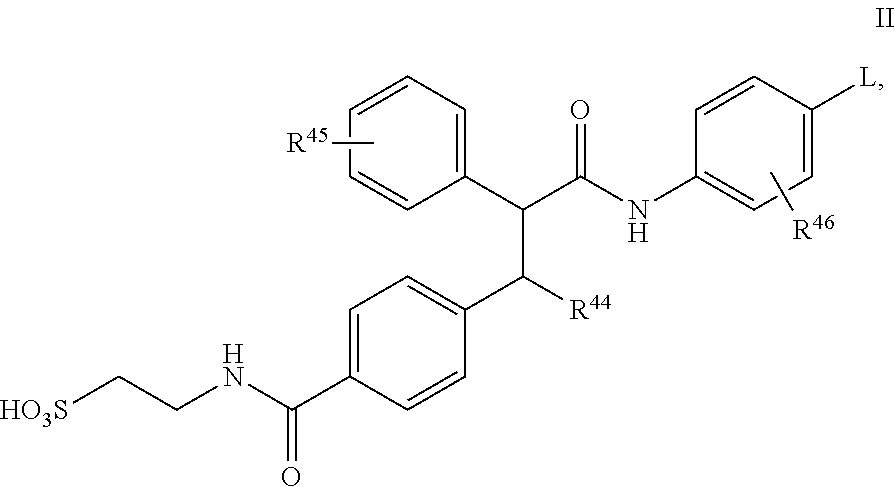Glucagon antagonists
a technology of glucagon receptors and antagonists, which is applied in the direction of biocide, drug composition, metabolic disorders, etc., can solve the problems of uncontrolled hyperglycemia, increased risk of microvascular and macrovascular diseases, etc., and achieves the effects of reducing the risk of development or progression, preventing, and delaying the time to ons
- Summary
- Abstract
- Description
- Claims
- Application Information
AI Technical Summary
Benefits of technology
Problems solved by technology
Method used
Image
Examples
example a
Human Glucagon Receptor Affinity
[0164]Compounds provided herein are dissolved in a suitable solvent (e.g., dimethlysulfoxide) at a concentration of 10 mM and then diluted in buffer (e.g., 50 mM Hepes, pH 7.4, 5 mM MgCl2, 1 mM CaCl2, and 0.2% BSA) to concentrations ranging from 1 nM to 100 μM. Compounds (20 μL / well) and [125I]glucagon at the final concentration of 0.125 nM (20 μl / well) (Perkin Elmer) are added to and mixed in wells of a 96-well plate (Costar, Corning) containing 120 μL of buffer. Next, an appropriate aliquot of a membrane preparation containing the human glucagon receptor (isolated from human liver samples or obtained from a recombinant cell line) is added to the wells. The binding mixtures are incubated for 2 hrs at room temperature. In the meantime, a MultiScreen 96-well filter plate (Millipore) is treated with 200 μL of the buffer, which is vacuumed through the filter just before the binding mixtures are transferred to the plate. At the end of incubation, binding ...
example b
Functional Antagonism in Hepatocytes from Various Species
[0172]Primary human, monkey, dog, rat, or mouse hepatocytes are seeded onto collagen-coated 24-well plates in Williams E medium (supplemented with 10% fetal bovine serum) and incubated at 37° C. overnight in M199 medium (supplemented with 15 mM glucose and 10 nM human insulin). The following day cells are washed twice with a glucose-free Kreb-bicarbonate buffer, pH 7.4, containing 0.1% BSA. Cells are then incubated at 37° C. with the aforementioned buffer containing 1 nM glucagon and varying concentrations of a glucagon antagonist (0-100 microM). Control wells without glucagon or antagonist are also included. After 1 hour, an aliquot of the medium is removed and analyzed for glucose content by means of the glucose oxidase method. The background glucose levels observed in the control wells are subtracted from the glucagon and antagonist containing wells. A graph of % glucose concentration vs drug concentration is plotted and an...
example c
Glucose Lowering in Diabetic Animals
[0177]The effects of compounds provided herein on blood glucose levels are assessed in animal models of type 1 or 2 diabetes such as, but not limited to, the db / db mouse, the Zucker fatty (ZF) rat, the Zucker diabetic (ZDF) rat, the glucagon-challenged dog, the alloxan- or streptozotocin-treated mouse or rat, the NOD mouse or the BB rat.
[0178]Compounds are dissolved in an appropriate vehicle such as polyethylene glycol-400 or cyclodextrin and administered to animals at doses of 0.1 to 100 mg / kg either by intraperitoneal injection, intravenous injection, or oral gavage. Animal models used in this evaluation [e.g., the db / db mouse, the ZF rat, the ZDF rat, the glucagon-challenged (0.3-5 μg / kg) dog, the alloxan- or streptozotocin-treated mouse or rat, the NOD mouse, or BB rat] are either freely-feeding or fasted from 3 to 24 hours prior to compound administration. In some instances, animals may be subjected to a glucose tolerance test following compo...
PUM
| Property | Measurement | Unit |
|---|---|---|
| optical purity | aaaaa | aaaaa |
| enantiomeric excess | aaaaa | aaaaa |
| enantiomeric excess | aaaaa | aaaaa |
Abstract
Description
Claims
Application Information
 Login to View More
Login to View More - R&D
- Intellectual Property
- Life Sciences
- Materials
- Tech Scout
- Unparalleled Data Quality
- Higher Quality Content
- 60% Fewer Hallucinations
Browse by: Latest US Patents, China's latest patents, Technical Efficacy Thesaurus, Application Domain, Technology Topic, Popular Technical Reports.
© 2025 PatSnap. All rights reserved.Legal|Privacy policy|Modern Slavery Act Transparency Statement|Sitemap|About US| Contact US: help@patsnap.com



